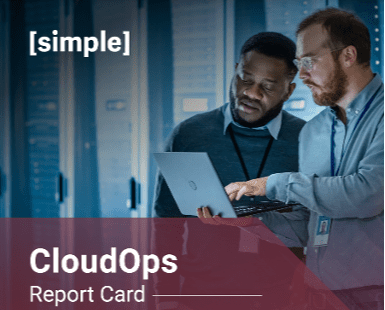cloud, cloud migration
Cloud Management: Achieving Scale Without Losing Control
The ability to seamlessly scale cloud infrastructure and applications — expand and contract services and resources on-demand – doesn’t happen automatically. Yet, it’s important to get this right. A big piece of scalability happens behind the scenes: how cloud infrastructure is architected, managed, and secured.
For example, 89% of federal IT decision makers said that consistency across cloud platforms is critical, yet only 20% rated their infrastructure as doing a very good job at it, according to a recent MeriTalk survey. As a result, they’re struggling with cloud management challenges including security, data governance, interoperability, compliance, and budgeting.

Agencies require the right cloud-related skill sets augmented by commercial off-the-shelf (COTS) and/or cloud-native solutions that integrate data across environments.
This article offers an overview of both COTS and cloud-native management solutions. Regardless of which direction you take, know that you’ll likely need to stitch together tools and services to retain overall control with cloud scale. For example, COTS tools that help organizations interface with the cloud often have to use native cloud services on the backend.
However, there are key capabilities you should look for in a comprehensive cloud management solution:
- Automation and orchestration - for applications and individual virtual machines
- Security - identity management and data protection and encryption
- Policy governance and compliance - auditing and service-level agreement metrics
- Performance monitoring - for infrastructure (instances, storage, networks) and applications
- Cost management - resource optimization, consolidated billing, and billing estimates
COTS Solutions
COTS tools have out-of-the-box capabilities that help agencies gain visibility. For example, they offer a console or dashboard for centralized management and security and a unified view of performance. Administrators and developers can set access policies and manage cloud configurations and clusters of virtual machines or compute resources — all in a single place.
COTS solutions include, but are not limited to: Google Anthos, IBM Cloud Paks, AppDynamics, OpenStack, Apache CloudStack, Cloudcheckr, Apptio, Rackware, Cisco Cloud Center, and ServiceNow ITOM.
Advantages of COTS:
- This approach is most appropriate in hybrid and multi-cloud environments which require integrating multiple data sources into a 3rd party platform. Teams remain “agnostic” and only have to learn and maintain one tool versus multiple cloud-native and on-premise services.
- Get multiple cloud management functionalities in one solution.
Disadvantages of COTS:
- Typically do not offer direct platform integrations or managed service offerings.
- It’s new software that must be updated and maintained, which increases IT complexity.
- COTS solutions may also create further complexity and higher costs associated with Kubernetes clusters if the middleware inside those environments are cloud-native services.
Looking to increase infrastructure performance, security, and cost savings? Find out how by downloading our Government's Guide to Achieving Cloud Scale.
Cloud-native Services
Cloud-native services emulate the cloud delivery model. They enable you to build, deploy, and operate applications frequently, predictably, and reliably. Cloud-native tools take advantage of a cloud-native architecture, which supports on-demand provisioning of storage, compute, and networking resources — whether in a public or private cloud.
All the major Cloud Service Provider’s offer multiple native management services to address automation and orchestration, security, policy governance and compliance, performance monitoring, and cost management. They include, but are not limited to:
- AWS Cloudwatch, Organizations, Configurations, Control Tower, and Management Console, CloudFormation, SSO
- Google Cloud Shell, Cloud API’s, Cloud Deployment Manager
- Microsoft Azure Resource Manager, Managed Applications, Lighthouse
Advantages of cloud-native tools:
- Better integration with the rest of the cloud platform
- Maintained within the core CSP platform by the ITOps/CloudOps team - no additional cost, training, or complexity
- Easier to achieve configuration and compliance consistency
Disadvantages of cloud-native tools:
- Requires “stitching together” multiple native capabilities - sometimes across clouds - to achieve comprehensive cloud management functionality
- Cloud management capabilities are available sooner in commercial cloud than GovCloud environments
We Can Help
Cloud management can get complex, fast. Simple Technology Solutions (STS) specializes in helping government agencies structure cloud environments for scalability, visibility, and control. We are:
- An Advanced, Small Business Multi-Cloud Provider. Our advanced partnerships include Amazon Web Services, Google Cloud Platform (GCP), Microsoft Azure, and more. We are the only 8a HUBZone small business with AWS Government competency and implemented one of the first FedRAMP compliant GCP IaaS cloud hosting environments in the federal government. With self-service templates and other "cookbooks," our automated approach is proven to reduce migration, provisioning, and onboarding timelines and seamlessly transition teams and applications to all the major cloud service providers (CSPs). The STS team has more than 100 technical professional certifications across these CSPs.
- Experienced. Our expertise includes a deep bench of engineers skilled in Agile, DevOps, CI/CD and Agile Lean processes. STS has successfully executed multiple enterprise legacy application migrations, with a library of proven cloud automation scripts brought into each engagement. We execute complex enterprise application migrations using infrastructure-as-code and fully automated continuous integration CI/CD pipelines.
- HubZone Commitment. STS is a HUBZone company dedicated to using technology to create jobs in underserved communities. We are passionate believers - and living proof! - that technology can be a socioeconomic onramp for minority groups historically left behind the digital divide. We leverage the STS Apprenticeship Program, the first Apprenticeship Program certified by DC Government, to develop individuals in HUBZone communities with little to no IT skills into cloud engineers.
Discover how we’ve helped government agencies architect and orchestrate their cloud environments for scale. You can schedule a meeting with me or download our free eBook resource, Government IT Executive's Guide to Achieving Cloud Scale, to see how we can help your organization.

You can also download our CloudOps Report Card to see if your cloud infrastructure is "up to snuff" and access tips on maximizing the effectiveness of your application migration project.


![[STS] Cloud Scale eBook Cover](https://blog.simpletechnology.io/hs-fs/hubfs/Premium%20Content/%5BSTS%5D%20Cloud%20Scale%20eBook%20Cover.jpg?width=332&name=%5BSTS%5D%20Cloud%20Scale%20eBook%20Cover.jpg)




